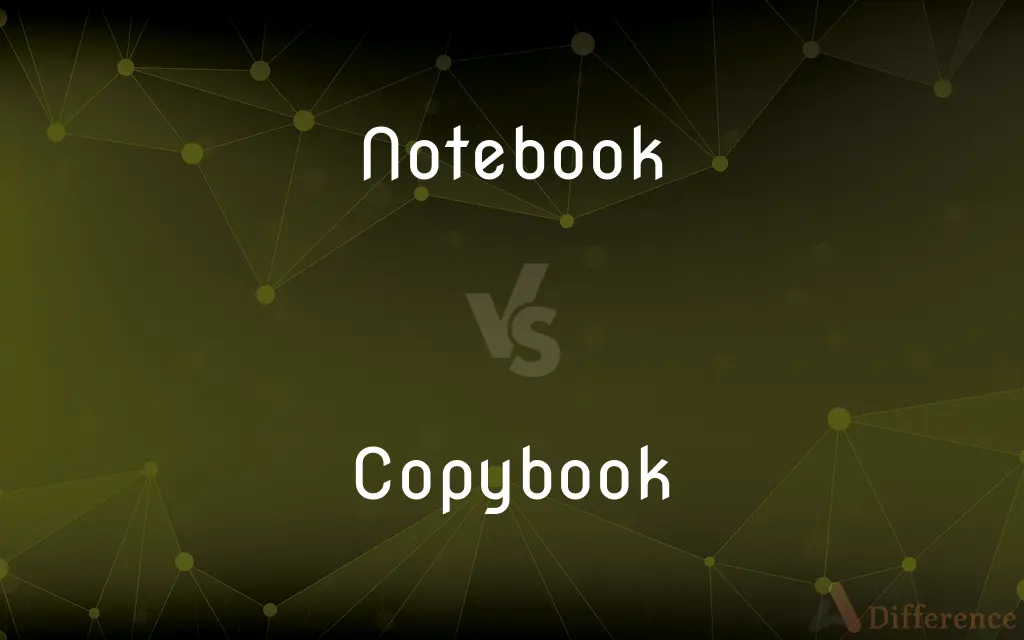Notebook vs. Copybook — What's the Difference?
By Maham Liaqat & Urooj Arif — Updated on March 12, 2024
A notebook is a blank book for writing notes, while a copybook is traditionally used for handwriting practice, often containing pre-printed examples.

Difference Between Notebook and Copybook
Table of Contents
ADVERTISEMENT
Key Differences
Notebooks are versatile blank books used for jotting down notes, ideas, sketches, or personal reflections. They come in various sizes, page types (lined, grid, blank), and bindings. Copybooks, in contrast, are educational tools designed specifically for students to practice handwriting or calligraphy, featuring pre-printed letters or sentences for replication.
The primary purpose of a notebook is to serve as a personal or professional space for writing, research, or creative expression, adaptable to the user's needs. Copybooks aim to improve handwriting skills, presenting examples for learners to imitate, thus focusing more on form and precision rather than content creation.
Notebooks can be used in a wide range of contexts, from academic settings to professional environments and personal use. They are flexible in their application, catering to any task that requires writing or drawing. Copybooks, however, are mostly used in educational contexts, particularly among young learners and those seeking to refine their penmanship or learn a new script.
The design and structure of notebooks vary widely, offering options like spiral-bound, hardcover, or softcover, with pages that can be plain, lined, or dotted. Copybooks often have a simpler design, focusing on functionality, with pages that contain specific patterns or texts intended for handwriting practice.
Notebooks are a staple in many people's everyday carry, suitable for capturing thoughts and information on the fly. They often become personal repositories of information over time. Copybooks, while used regularly in certain learning phases, serve a more temporary purpose, focusing on the development of a specific skill.
ADVERTISEMENT
Comparison Chart
Purpose
General writing, notes, sketches
Handwriting practice
Content
Blank, lined, grid, or dotted pages
Pre-printed examples for imitation
Use Context
Personal, academic, professional
Educational, especially for young learners
Design
Varied (spiral, hardcover, softcover)
Simpler, focused on handwriting practice
Focus
Versatility and personal expression
Improving penmanship or learning scripts
Compare with Definitions
Notebook
A book of blank pages for writing, drawing, or recording notes.
She kept a notebook by her bedside for late-night inspirations.
Copybook
A practice book containing examples to improve handwriting.
In calligraphy class, each student had a copybook for practicing letterforms.
Notebook
Comes in various formats and styles to suit different needs.
His dotted notebook was essential for both note-taking and architectural sketches.
Copybook
Focuses on repetition and practice for skill improvement.
Daily exercises in her copybook improved her cursive dramatically.
Notebook
Essential tool for creativity and organization.
Keeping a notebook helped her stay organized with her tasks and ideas.
Copybook
Often used in elementary education to teach writing.
His first-grade copybook was filled with lines of carefully traced letters.
Notebook
Can be personalized or embellished to reflect the owner's style.
The artist's notebook was covered in colorful stickers and doodles.
Copybook
May include various scripts or styles for learners.
The copybook offered examples in both traditional and modern calligraphy.
Notebook
Used across all age groups and professions.
The researcher filled her notebook with observations from the field.
Copybook
Temporary in use, aimed at mastering a particular skill.
Once he mastered his letters, the copybook was replaced with blank notebooks for free writing.
Notebook
A book of blank pages for notes.
Copybook
An exercise book containing models of penmanship, used in teaching handwriting.
Notebook
A light, portable computer that is generally thinner than a laptop.
Copybook
Unoriginal; trite
Used copybook phrases in the essay.
Notebook
A book in which notes or memoranda are written.
Copybook
A student's exercise book containing samples of good handwriting to be copied.
Notebook
A kind of user interface in literate programming, allowing calculations to be interspersed with human-readable comments, diagrams, etc.
Copybook
A notebook containing blank, often lined, pages for writing answers.
Notebook
Ellipsis of notebook computer
Copybook
A series of instructions or data definitions copied into multiple programs from a shared library; boilerplate.
Notebook
A book in which notes or memorandums are written.
Copybook
A book containing models of good penmanship; used in teaching penmanship.
Notebook
A book in which notes of hand are registered.
Copybook
A book containing models of good penmanship; used in teaching penmanship
Notebook
A book with blank pages for recording notes or memoranda
Notebook
A small compact portable computer
Common Curiosities
Why would someone choose a copybook over a notebook for handwriting?
For structured practice and guidance in improving handwriting or learning calligraphy, a copybook provides specific examples to follow.
What is the main difference between a notebook and a copybook?
A notebook is used for general writing and notes, while a copybook is designed for handwriting practice with pre-printed examples.
How do the page layouts differ between notebooks and copybooks?
Notebooks come with blank, lined, grid, or dotted pages, whereas copybooks contain lines or characters for tracing and copying.
Are copybooks only for children?
Primarily, but elders learning calligraphy or a new script may also use them.
Are digital versions of notebooks and copybooks available?
Digital versions of both exist, with apps and software mimicking the experience for note-taking, sketching, and handwriting practice on tablets or computers.
How do environmental considerations affect the choice between notebooks and copybooks?
Eco-conscious choices might include notebooks and copybooks made from recycled materials or digital alternatives to minimize paper use.
Can notebooks be used for handwriting practice?
Yes, notebooks can be used for handwriting practice, though they lack the pre-printed guides found in copybooks.
Do professionals use notebooks or copybooks?
Professionals predominantly use notebooks for notes and project planning, while copybooks are less common in professional settings, except perhaps in calligraphy or design.
How does the material quality compare between notebooks and copybooks?
Notebooks may come in a range of qualities, including high-end options with premium paper. Copybooks focus on functionality, so while paper quality varies, it's generally optimized for writing practice rather than luxury.
Can a copybook be customized?
Copybooks are less likely to be customized due to their educational nature, but some may offer different handwriting styles or scripts.
Share Your Discovery

Previous Comparison
Anesthesia vs. Anaesthesia
Next Comparison
Councillor vs. CounsellorAuthor Spotlight
Written by
Maham LiaqatCo-written by
Urooj ArifUrooj is a skilled content writer at Ask Difference, known for her exceptional ability to simplify complex topics into engaging and informative content. With a passion for research and a flair for clear, concise writing, she consistently delivers articles that resonate with our diverse audience.














































